Physiosensing Rehab III Balance Assessment and Recovery Unit. Neurorehabilitation, Posturography and Physical Rehabilitation.
Shipping in 3-5 days approx.
Description
The physiosensing balance assessment and recovery unit is designed as a comprehensive solution for those who want to establish a specific balance unit in their centre. It consists of one of the leading platforms on the market integrated into a perfectly adapted cart such as the Mobile Cart Plus, with a specific computer for managing the platform, perfectly adapted to its software and a high-quality 27-inch monitor.
PhysioSensing's balance unit is the best example of the new generation of products for physical rehabilitation, balance improvement, neurorehabilitation and postural health care. Physiosensing is based on state-of-the-art technology.
Ideal for use by physiotherapists and specialists in neurorehabilitation or posturography.
The Physiosensing Rehabilitation version is specially designed to study how musculoskeletal disorders affect body stability and balance. The platform achieves results that are as immediate as they are accurate.
A 2-hour Zoom training is included with the purchase of the platform, carrying bag and Foam.
Treatment areas:
Many neuromusculoskeletal injuries affect patients' balance. With the PhysioSensing Rehab III platform, patients' balance can be assessed and analysed in order to work on it and improve it. All with a single platform that also carries out the assessment in a minimally invasive way for patients and with immediate precision and analysis for the professional.
With the Physiosensing Rehabilitation platform you can analyze:
- Balance: A platform that displays the center of weight of the body mass on a screen. Clinical balance assessment helps to avoid fall risks and determine the reasons underlying balance disorders. The benefits of using force platforms for balance assessment come from their ability to measure the Center of Pressure (CoP).
- Baropodometry: The plantar pressure map is a method for measuring the pressures on the surface of the foot, whether in a standing or moving position. The static and dynamic analysis is performed on a baropodometry platform, through which the pressure exerted by the feet is measured, whether in a standing or walking position.
- Posturography: Computerized posturography systems use force platforms to measure a patient's sway by determining instantaneous center of pressure (CoP) movements. The collected CoP data can be visualized through a statokinesiogram and a stabilogram.
- Visual biofeedback: Visual biofeedback (VB) is a rehabilitation method that can be used during static balance training, which provides the patient with visual information about the position of the centre of gravity when the patient is standing on a platform. VB stimulates motivation, proprioceptive information, simulates body movements and provides valuable information for the healthcare professional.
Pressure platform:
The PhysioSensing pressure platform stands out for its precision (thanks to its more than 1,600 sensors), for its portable nature (thanks to the fact that it barely exceeds four kilos in weight) and for its low cost . In addition, when combined with the podometry/balance software, it becomes an invaluable tool for clinical practices and baropodometric measurements.
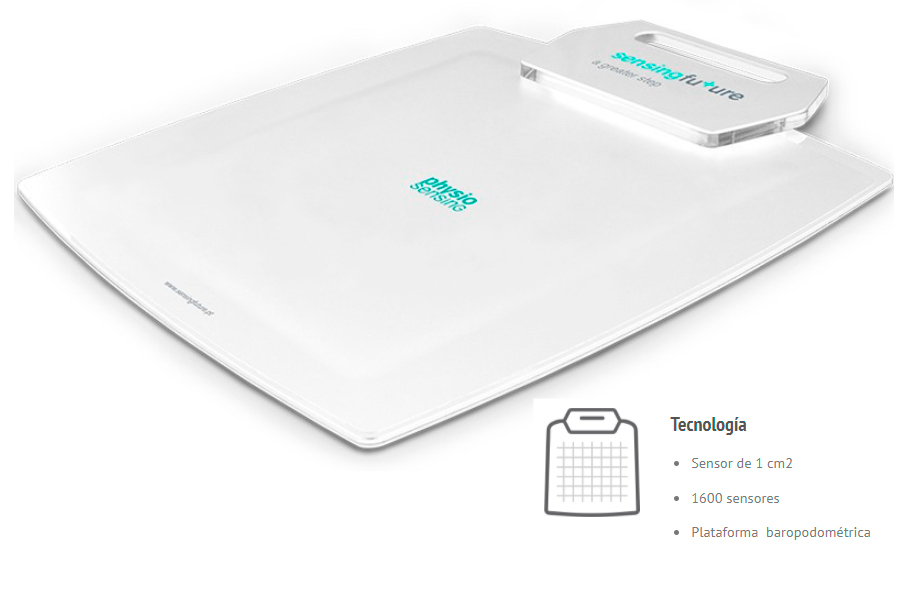
Technical characteristics:
- CE Class I medical device according to directive 93/42/CEE
- Portable Type
- Dimensions: 61 x 58 x 1 cm
- Weight 4 kg
- Active surface 40 x 40 cm
- Number of sensors 1600
- Sensor size 1 x 1 cm
- Sensor type Resistive
- Sensor lifespan over 1,000,000 actuations
- Maximum pressure (each sensor) 100 N/cm2
- Temperature range from 0ºC to 60ºC
- USB connection/power
- Frequency 100 Hz (100 samples/second)
PC Requirements
- i3 CPU processor, Quad-Core, with 2GHz
- RAM 4 GB
- USB 2.0 or 3.0 ports
- Windows 7, 8, 10 (32 or 64-bit) Operating System
Podometry software included in Rehab III:
Podometry software allows the professional to carry out a triple measurement of plantar pressure:
- Static analysis
- Dynamic analysis (gait)
- Postural analysis
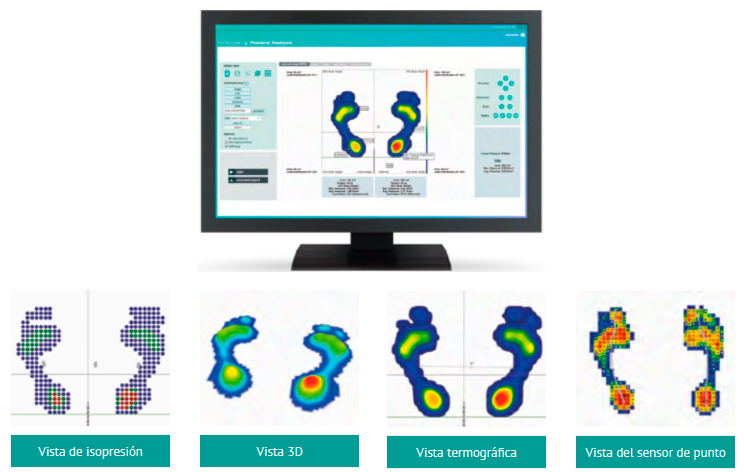
Thanks to its powerful software, it allows you to create a complete map of plantar pressure in which you can calculate:
- Static mapping with center of pressure
- Average and maximum pressure calculations
- Weight distribution
- Measurement possibilities (length, angle, pressure, area)
- Exam comparison
- Statokinesigram and Stabilogram
In addition to static and postural analysis of plantar pressure, PhysioSensing PODO will allow you to perform dynamic analysis in which the distribution of plantar pressure on the platform can be measured during a cycle of one or four steps.
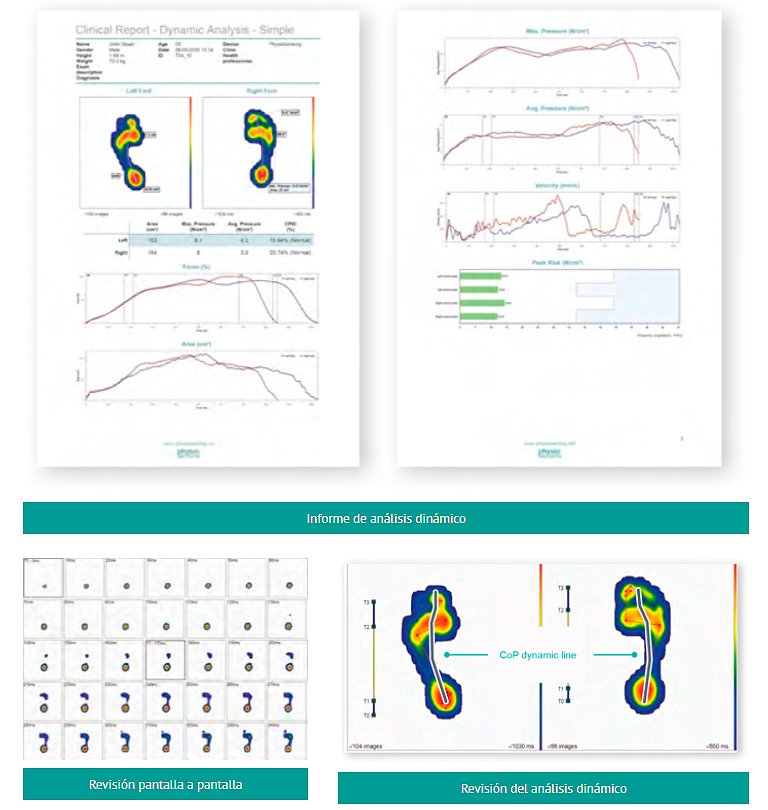
Analysis in which the following aspects can be assessed:
- CPEI
- CoP Line
- Force, area, pressure and velocity graphs
- PEAK Risk
- Phases of the gait cycle
Balance Software Included in the Rehab III Platform:
Balance software is a powerful balance assessment and training tool. Within the analysis area, the software is able to assess:
mCTSIB – Modified Clinical Test of Sensory Integration and Balance and Romberg test
This protocol allows the measurement of static balance in four sensory conditions: stable surface and eyes open; stable surface and eyes closed; unstable surface and eyes open and unstable surface and eyes closed.
Body swing
You can create a custom posturography. Define the initial conditions and obtain the variation of CoP, ML and AP over time. It also includes more than 30 parameters derived from a posturographic examination including Fourier analysis.
Limits of stability (LOS)
Perhaps the most widely used protocol for balance assessment, this protocol quantifies directional control and the maximum distance the patient can reach with their center of pressure in 8 different directions.
Risk of falling
To measure static balance under four conditions: comfortable posture with eyes open and eyes closed, use narrow posture with eyes open and eyes closed. After performing the performance, the swing velocity index value appears and provides a prediction of the risk of falling.
Rhythmic weight shift
Use the Rhythmic Weight Shift protocol to assess the ability to rhythmically transfer the center of pressure in the sagittal and anteroposterior planes at three different speeds.
Unilateral position
To measure balance in four conditions: left foot raised with eyes open, left foot raised with eyes closed, right foot raised with eyes open and right foot raised with eyes closed.
Balance Error Scoring System
The BESS protocol allows to measure postural stability with eyes closed in three different positions on two types of surfaces (firm and unstable): two feet together, single-leg position and tandem.
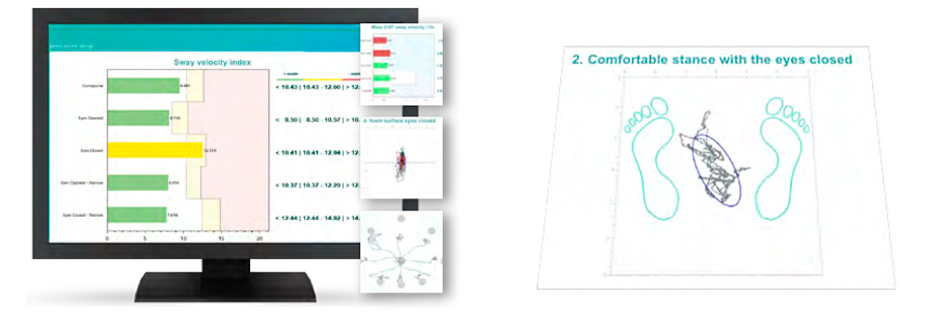
The software does not stop at merely evaluating balance, but proposes a series of exercises to improve body balance through training. These are the following:
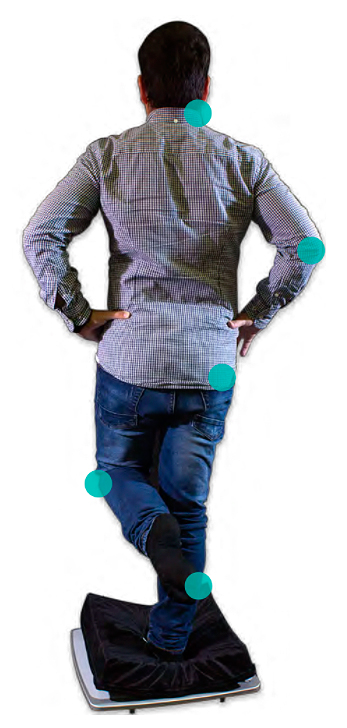
- In the sagittal and anteroposterior exercises , the patient must reach the balance position in the sagittal plane or in the anteroposterior plane.
- In the web, tunnel, dot pattern and bar pattern exercises , the goal is to maintain a balanced position despite the visual stimulus.
- In the Route Bars, Route Spiral, Route Square and Route Maze exercises the objective is to travel the routes within their limits with the center of pressure, following the red dots.
- In the Square, Circle, Eight and Spiral exercises , the patient must reach all the points arranged in the manner indicated in the name.
- In the Follow the Point and Moving Route exercises , the objective is to reach the moving red dot and follow it within your tolerance margin.
Software Comparison:
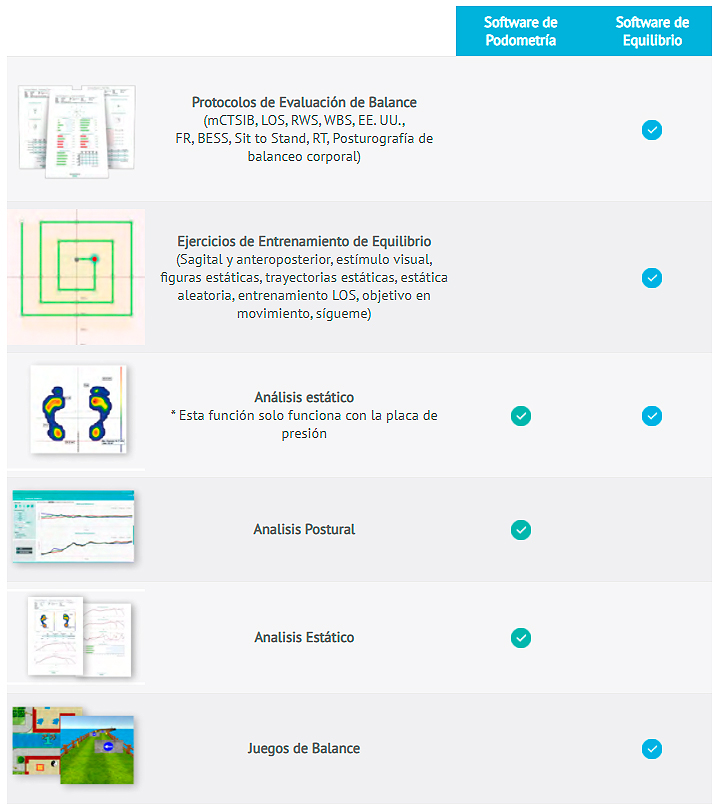
Warranty:
The device has a 2-year warranty.















